Bill Morrison Revivifies Dying Filmstock
posted December 29, 2010 1 Comment
![]()
Renowned experimental filmmaker Bill Morrison has an unusual relation to the world of moving-image archives: He uses decaying film stock as his raw material. He has become synonymous with the found-footage film, as he uses the inherent qualities of nitrate-film-stock deterioration for various artistic, expressive ends. (And, as he says, because “it looks really cool.”)
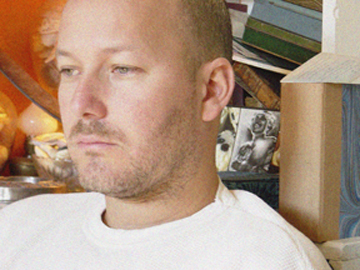
Photo: Laurie Olinder
Rather than seek to restore deteriorating film, he forges his art from footage that archivists would consider ripe for restoration, or past preserving.
There is method to his contrarious approach. In a statement for a retrospective of his work at the Cork Film Festival in Ireland in 2006, he wrote: “Like our own bodies, this celluloid is a fragile and ephemeral medium that can deteriorate in countless ways.” Beyond that corporeal, concrete reality lies another dimension, he said: The decaying images are like desires, or memories, like “actions that take place in the mind.”
In its relation to modern life, film stock has a particular, telling aspect, Morrison adds: Film is rare among art forms in that it can be documented from its inception to its current form – and its documents are themselves available for art-making.
The New York-based filmmaker is currently working on The Great Flood, a 75-minute project with original music composed by idiosyncratic guitarist Bill Frisell, who will also perform it live at showings of the film, with jazz(-ish) quartet. It uses footage of the Mississippi River Flood of 1927 and the changes it forged in American society and particularly music when displaced Southerners migrated in mass to the North.
Morrison is using footage of the flood that he located in the Fox Movietone News Film Archive, the Pathé collection, the Library of Congress, and the National Archives. Because the footage was shot on volatile nitrate stock, it is now pockmarked and partially deteriorated – just the kind of raw material that Morrison loves to use.
Morrison and Frisell collaborated in 2003 on the film The Mesmerist. There, distorted images of a nitrate print suggested different planes of reality – the lived, the dreamt, and the remembered. Morrison will use a similar approach in The Great Flood. He talks, for example, of using the bubbles and washes of decaying footage, whose deterioration suggests that it, too, has been submerged in flood waters, to suggest the destructive force of the deluge.
In an interview with MIAN (see, below), recorded on November 9 2010 in New York, Morrison detailed the project, for which he and Frisell are in the final stages of fundraising.
Among planned components of The Great Flood is a Bill Frisell Quartet tour with the film, starting in September 2011, along the route that sharecroppers took during the exodus from the South to northern cities such as Chicago. At concert stops along the way, Frisell and his top-flight bandmembers, Ron Miles (cornet), Tony Scherr (bass), and Kenny Wollesen (drums), will perform the music that Frisell is composing. It will be, says Morrison, in distinctive Frisell style: an eclectic mix of Delta blues, R&B, and rock n’ roll on a jazz(-ish) base.
En route to Chicago, the film’s tour will follow the so-called Great Migration that took southern farmers and townsfolk from New Orleans and other parts of the South up through Clarksdale, Miss., Memphis, and beyond.
Morrison has often collaborated with musicians and theater productions. He has long worked with Ridge Theater in New York and screened his films in installations, concerts, and other performance settings. Sound is regularly a key element of his films’ resonance. With Bill Frisell, he has previously made the semi-documentary, The Film of Her (1996), a short in which a man haunted by memories of a silent stag movie becomes a film archivist, and The Mesmerist (2003), a reconfiguration of an earlier film starring Lionel Barrymore and Boris Karloff.
Excerpt of a live performance of The Bill Frisell trio performing with Bill Morrison’s “The Mesmerist” in St. Pölten, Austria, February 19, 2010:Morrison also worked to great acclaim with Michael Gordon on his best-known, and hugely acclaimed feature-length Decasia (2002; more clips here & here), as well as on City Walk (2003), and the celebrated, eight-minute Light is Calling (2004). It used decayed footage from the 1926 film, The Bells – among them, deliquescent images of a military horseman and his true love in radiant, tumbling light (available online in full).
http://vimeo.com/15400248
Among Morrison and Gordon’s other collaborations was Gotham (2004), a “symphony-film.”
Morrison has not always used archival film. For example, for East River (2003), he used newly shot images. For Porch (2005), he used found home-movie footage. But archival footage certainly is his signature raw material, employed in his most celebrated works. Among those are the feature-length Decasia (2002), one of the most acclaimed of all American experimental films. Morrison arranged varied imagery, much of it on nitrate filmstock – bits and pieces of melodramatic silents, ethnographic films, travelogues, newsreel footage, wildlife documentaries…. – that seems to dissolve into oblivion, and set his cut to an avant-garde symphonic score by Gordon.
[nggallery id=16 template=”galleryview”]Among Morrison’s recent works is Release, a site-specific installation relating to the 80th anniversary of Al Capone’s release that has been up in a cell at the historical Eastern State Penitentiary in Philadelphia since March (it closes on November 30, 2010). On that project, Morrison worked with jazz pianist Vijay Iyer. The film had its theatrical release at the Tribeca Film Festival, in April 2010.
In July 2010, Morrison’s The Miners’ Hymns premiered at the BRASS: Durham (England) International Festival 2010 Like The Great Flood, that work was an evening-length film. Morrison made the film using archival footage of the mines and miners of Northeastern England. His musical collaborators were the Icelandic composer Johann Johannsson and, in live performances, brass ensembles from around Durham.
Also among Morrison’s recent work is Spark of Being, a film that reinterprets the Frankenstein myth, with live performance by trumpeter Dave Douglas. It premiered in April 2010 in Stanford, Cal.
A selection of clips of Morrison’s work is available on Vimeo.com.
In this interview, made by Peter Monaghan in New York on November 9 2010, with email follow-ups during December 2010, Morrison talks about his long friendship and collaboration with Frisell, which has included using Frisell recordings on some of his short films.
MIAN: an interesting aspect of your new film about the Great Mississippi Flood of 1927, with music by guitarist Bill Frisell, is that you’re making a film that uses moving image archives, as you often have before. What stage is your new film at?
Bill Morrison: Bill Frisell’s management team has done a remarkable job of raising money for this, through grants and co-commissions.
I’ve made HD transfers of footage from the National Archives, some of it specifically about the 1927 Mississippi River Flood. We’ve got gorgeous material from there. We’re working on doing the same with footage from the Library of Congress.
Why did you decide on that particular subject?
A frequent collaborator of mine is the composer Michael Gordon, and he and I worked on Decasia, but we’ve done eight or nine other projects. One of them was the final piece for a multimedia performance project called Shelter, and he composed a 12-minute piece called What We Build, and I interpreted that using flood footage from various continents, countries, states, decades, and really looked for deteriorating flood footage, basically.
Some of that actually was from the ’27 flood. I got interested in it, then. I read John Barry’s book Rising Tide [subtitle: The Great Mississippi Flood of 1927 and How It Changed America, Simon & Schuster, 1998]. PBS’s American Experience aired Fatal Flood, an independent production that was largely based on Barry’s book. Similarly, there was a Broadway play with music, On The Levee, that was also influenced by the narrative of Rising Tide.
While Barry’s book has been essential reading for us, we are not re-telling the story of how the flood affected LeRoy Percy and the people of Greenville, MS. We are gathering news footage that was shot before, during, and after the flood, and editing it to a new suite of music that Bill Frisell is composing.
As all footage documenting this catastrophe was shot on the volatile nitrate stock, much of what remains is pockmarked and partially deteriorated. The emulsion deterioration forms a visual counterpoint to the photographed image underneath it. And these two layers of visual information correspond to different parts of the music simultaneously. When paired with Frisell’s music, the footage becomes contemporary again. All its pockmarks and permutations announce its contemporariness: It is footage that took exactly this long to look as it does today. We see the images through a prism of history, but one that dances with the sound of Bill’s music.
What role did the flood play in migration from the South to the North – migration of people and culture?
Of course you can’t put your finger on any one thing that’s the cause of why something happened, but you can make the case that this rather random meteorological event, that was really caused by a lot of rain, killed the crop for one season and gave sharecroppers a chance to say, hey, I’m not going to get paid anyway so I may as well jump ship from these plantations. There was a mass exodus from the South to the North. Or course, we all know that music like Led Zeppelin came directly from that. Directly. The Delta blues goes up to Chicago and becomes Chicago blues, rhythm and blues, in Detroit. Rock and roll, hip-hop, whatever you want to say, you can trace it back if not from 1927, from before or after right around that time, and you can say: Somebody sat there and worked out those chord progressions; we don’t know who did it but it started somewhere and it was within these decades, so the ’27 flood becomes a great metaphor for that.
When I first considered this project, I knew I wanted Bill Frisell to create the musical narrative.
When I first considered this project, I knew I wanted Bill Frisell to create the musical narrative for this evolution. Bill’s sound is so uniquely his own that he can make almost any genre of music sound like a personal meditation – one that has distilled a number of disparate influences into a singular voice. We are looking at the ’27 Flood from a vantage point of where we are today, more than 80 years later, and how this singular event contributed to form the society we live in today, and to influence a Bill Frisell.
That’s an interesting aspect of Bill Frisell’s music that he brings all that in a seamless way? That’s testimony to his generosity of spirit.
Absolutely. He’s someone whom I came in contact with through his music from some of his earlier recordings on ECM in the 80s. But, I guess it would be the early 90s, ’90 to ’94, I held a job in the kitchen of the Village Vanguard. Bill would come down there probably twice a year. So around that time I saw him a couple of times a year. His music seemed very different from the other music that was being performed at the Village Vanguard, and it attracted a different crowd, but an incredibly enthusiastic and loyal crowd who were just ready to be transported. Before too long, I became one of them.
What were you doing at the Vanguard?
I was a dishwasher, bar-back.
Were you already making films at that point?
Yeah, I was making experimental films of my own, and with a theatrical company that was doing multimedia performance work. I was often making films during the day and then was working at the club at night. Sometimes going between a day shift and a night shift to run projections at La Mama Theater.
But I met a lot of great jazz musicians through that time, and the Vanguard is a sort of inner sanctum of jazz, so most people are ushered out, but the busboy gets to be there, and the dishwasher gets to be there, regardless of who’s in there. They get to go in and out, and to hang out. So musicians learn who that person is, pretty early on. Between the owner and the staff coming and going, it’s a very intimate setting.
So that’s how you came to know Bill personally?
Yeah, I made a film not too long after that, using use one of his prerecorded tracks on a film of mine, called Film Of Her [1996] and then some years later he asked me to make another film for him that was part of a commission he was getting from the World Financial Center, for their guitar festival. And the intention at that time was that I would make a film and he would score it with an original sound track; but I used a scratch track of two tracks of his from his trio recording with Dave Holland and Elvin Jones [“Tell Your Ma, Tell Your Pa” and “Again” from Bill Frisell with Dave Holland and Elvin Jones, Nonesuch, 2001], and after he heard that he said, “Forget it, we have to use that.”
You talked about the Flood as a metaphor for the spread of Southern culture into the rest of the U.S. and the world. But I take it that there must be something about the idea of floods, as decay and overwhelming force, and so forth, that metaphorically appeals to you, does it?
Again going back to 2005, of course the media flooded, if you will, with images of Katrina, so it’s sort of a recurring disaster, there, that we can’t really get a grip on. This year, and last year, we’ve had huge floods, so you look at our planet being two-thirds water, it’s an ongoing issue that never loses its relevance. Going back to Biblical times, it’s been obviously an issue that people have dealt with all along. So it’s sort of a great evener; no matter how technologically advanced we get, it’s still going to be there. It’s a great leveler. Couple that with some of the social issues that are still relevant. There were the dynamics that played out in Katrina – who gets to live on higher ground, who on lower ground.
And then almost always floods, since they could, have attracted photographers and cinematographers. It’s just a stunningly abstract view of the landscape than we’re otherwise familiar with. So there is this footage, usually aerials but also floating-boat shots. Ironically I was also working on a Katrina piece earlier this year, Ted Hearns’ Katrina Ballads, and it’s amazing how contemporary the footage of Katrina looks; it’s almost the same as the footage of the ’27 floods, only with fewer pockmarks.
Film is stuff that has a physical presence in the world that’s given to distress and decay like the rest of us are, and like many of our memories are.
The appeal to you of decaying film is well known, but is there some particular link from that to the flood, for you?
Well, for instance, it’s an event that most people don’t remember. It’s a decaying history of the US. Most people read a brief paragraph to bring them up to speed about the 1927 floods and it’s only in framing the terms of this musical history that people would even see what the significance of it is. Or, perhaps engineering history, or something like this. For me that speaks very much to the ephemeral nature of film. It’s stuff that has a physical presence in the world that’s given to distress and decay like the rest of us are, and like many of our memories are.
So, the nature of old film is that it’s shot on nitrate and is very volatile and fragile, so we’re going to get those pop marks and scratches and in some cases nitrate deterioration.
I would still be fascinated with this footage if it was pristine, in this case.
Of course I’ve made a lot of films where the decay is more central, but in this case it’s a byproduct, and a fitting byproduct.
Will this film be more literal, if I can use that term?
It will be, in a certain way, but there’s a story about the powers that be that created the situation on the Mississippi, and we’re not so interested in that. It became a Broadway play at Lincoln Center last year [2009] or this year [2010], and a PBS documentary and a book, that I mentioned. We’re more interested in the aftermath, what it looked like, less about the standard documentary.
So I would say it’s literal but with a lot of space between the words, you could say.
This is really quite gorgeous footage, the flyovers of flooded plains.
Who made the original footage? What range of material is there?
That I’ve located, there is Fox Movietone, there is Pathé, there is an independent film that’s housed at the National Archives; there’s a host of supporting stuff from 1927 from the South in the National Archives. There’s a German film and another independent film at the Library of Congress. So from primary sources, there are five. And then there’s quite a bit else out there. There has to be other news footage other than Movietone and Pathé. So we’re really just cranking up the search now and trying to find as much as we can.
Do you have a tried and trusted method for finding film in archives?
Well, because I’ve been in this archive world for a few years, I’ve got a few friends. With the government agencies, you’ve just got to go to their websites and go through the rather labrynthine processes.
I do have friends at the Library of Congress, like George Willeman who steer me in the right direction. George is the nitrate-vault manager in Culpeper. With the University of South Carolina, I have a long history with them. They’re very generous with me and there’s quite an amazing collection down there.
It’s usually a many-step process to get a little piece of film, but then to do something artful with it is a joy that comes at the end.
Is it harder to get decayed film than well-preserved film? Archivists tend to like well-preserved film.
Older film shrinks and that makes it very difficult to transfer. Nitrate film has the even more difficult tendency to stick together and become what’s referred to as decom donuts or hockey pucks. There are some people who’ve done some great work in loosening those things up. And again I have to credit Russ Suniewick at Colorlab who’s taken some stuff, soaked it, unspooled it, adjusted it so it scans. So, in the right hands a lab can deal with it. Most labs won’t have the time or don’t have the resources to spend that much time. Russ happens to be very interested in it and appreciates my enthusiasm for it. When I have a budget to deal with it, it’s a great reclamation project. Once it’s preserved other people can have access to it as well.
In the case of an earlier film I did with Bill Frisell, The Mesmerist, we took some deteriorated rolls from a 1927 feature starring Boris Karloff and Lionel Barrymore titled The Bells.
My autobiography ought to be called “A Pile of Garbage with My Name on It.”
You work in that weird sensitive area for archivists where they have to admit at a certain point that film is not reclaimable according to the film archivist’s ethos. It sounds like there should be a nationwide alert – if your film’s no good, give it to Bill Morrison.
Well, actually there is something like that, at the Library of Congress. It’s called the Bill Morrison Pile. It always warms my heart to see, when I visit the Library of Congress nitrate vaults in Culpeper, at Mount Pony, they’ve set aside a pile of films that otherwise would be thrown away, with a poster note on it with my name. Somebody once suggested that my autobiography ought to be called “A Pile of Garbage with My Name on It.”
That’s again credit to George Willeman, the vault manager there, who looks out for me. He says that to people who like my work, he’s my supplier; to people who don’t like my work, he’s my enabler.
The way your work relates to archivists is so interesting. Are you pointing out that there is something that can be reclaimed from the transience, not just the originals? And that not all things are worth preserving in their original state, or perhaps something is better made of it than to keep it as it was?
It’s funny because when I first started approaching archives, occasionally but not too often people had heard of me and the general, rote response was as if I was asking to see their dirty laundry. They’d say, No, we don’t have deteriorating or decayed footage. Invariably I’d find someone of about my age working at the archive who would start talking to me and would pull something out. For the archivists, it’s the stuff that might get de-accessioned, and at that point it becomes available to me. So I am walking a fine line between what is held by an archive and what is about to slip off into the void.
Do you have a sense of why you relate to the aesthetic of that transient nature of the medium? Why that rather than, say, the pristine nature of new film.
I was trained as a painter, and from painting I drifted to animation and then film. The thing that interested me was how each frame looked different, and each frame sort of had a different meaning. And the way we perceive film is like a collection of paintings or a collection of different images. That had also philosophical implications for me because of course the way we perceive life is as a collection of discrete events, whether we think about them as throughout our life or just really a day or walking here to this coffee shop. There’s a bunch of different pieces of information that we’re synthesizing into a whole. Our memory gets it.
So you break down the fluidity of film and its allusion, to see what creates the allusion?
Typically an audience wants to lose themselves in the movie. We enter the illusion of the moving picture willfully, and the degree to which a film is successful is often gauged by how easily it sweeps us up into its world. A film that has blotches and blemishes in not as easily entered, however. The eye seeks out recognizable forms, and strives to create continuity between them. But they are constantly being reminded that they are watching a plastic medium that has some shadows trapped from another time. And while that medium is at once unrolling before us in contemporary time, it is, on another time level, continuing to deteriorate. So the audience member is always made aware of him or herself as being just that: a viewer who has been placed in this weird limbo of at once striving to enter the illusion of the film, and being kept at bay by that which houses it. And that tension, when successful, creates a somewhat meditative state in those who are receptive to it. So that’s the real sweet spot that I try to find.
And if I were to trace back an “a-ha” moment with my working with nitrate film, it would certainly be Peter Delpeut’s Lyrical Nitrate, which I saw that at Film Forum 20 years ago. The final scene, at least I remember it as being the final scene, is of Eve offering Adam an apple and all hell breaking loose. For me that encapsulated so much of what I believed art could be. Ten years later I came across similar footage, with similar effects, and I realized that I just wanted to make a film about how decay transforms the meaning of an image.
What will be the general schema of this new film with Bill Frisell. Do you have a developmental line in mind for it?
Yeah, there are a few different things that are happening, but they’re all in the form of a river, from the tributaries that are being flooded feeding into an enormous river that is roaring, to a community that’s basically fractured and living under the auspices of plantations, that then comes together to form newer communities up North. There’s water going this way and the people going the other way, and in both cases gaining strength.
I let the imagery speak to me a lot, and give myself a lot of ability to move laterally in these pieces. I’m not making a straight documentary, and I allow myself to let the images dictate the direction the film will take as a whole. I’m putting together assemblages for Bill, and he’s writing music that he will start rehearsing, performing and recording.
This year we’re hoping that Bill can begin a grass-roots tour with the same ensemble of guys, Ron Miles, Tony Scherr, and Kenny Wollesen that will start in New Orleans and work their way north, presumably to Memphis and Chicago, writing and playing along with way. I’d very much like to be along on that trip, if I can work that out with my schedule. A lot of the flavor could come from that trip. And I’d love to document it. So once Bill has the music, I very much want him to be able to design what he thinks is a nice suite of music.
Do you work with composers who are particularly sympathetic to the nature of film as you see it?
I certainly don’t seek out composers who share my personal philosophy about film. I do welcome collaborators who have a unique approach to music. With Decasia we went about collecting deteriorated images, so Michael Gordon wrote what he thought a “decaying” symphony would sound like. But in general, I try to make a film that follows certain parameters I have set for the visual contents, as the composer has set a corresponding set of parameters for the music. I want the music to develop organically on its own terms as much as possible, and for the film to be able to do the same. At some point I will adapt what I have constructed to a draft of the music, and then we will tweak that from both sides.
In 2010 Morrison premiered new collaborations with a number of great composers, including Release with avant-garde jazz pianist Vijay Iyer at Eastern State Penitentiary, Spark of Being with trumpeter Dave Douglas and Keystone at Stanford Lively Arts, Blondes with performance artist Laurie Anderson at the Sydney Opera House, The Miners’ Hymns with electronic experimentalist Jóhann Jóhannsson at Durham Cathedral (UK), Katrina Ballads with new music composer and performer Ted Hearne at Le Poisson Rouge (NYC) and Houston’s Hobby Center, and Persesphone with trumpeter composer Ben Neill and vocalist Mimi Goese at the BAM Next Wave 2010.
In 2011 the British Film Institute will release The Miners’ Hymns on DVD, and will re-release Decasia with a number of shorts.
The Great Flood will premiere at the University of Illinois’ Krannert Center in September 2011, and will appear at Zankel Hall, NYC, in November 2011.
Previous Post: A New Book on Tennessee Williams' Movie Colleagues
Next Post: Bill Morrison, Poet of Decaying Film Stock

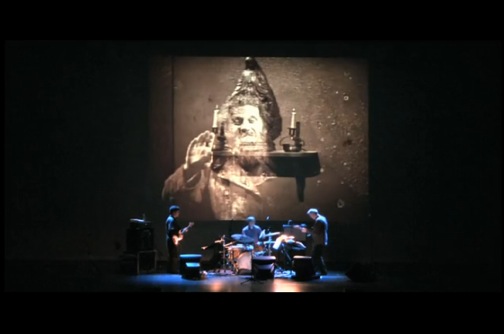

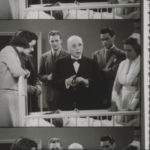


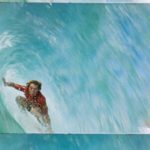
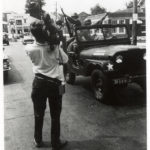
Comment (1)